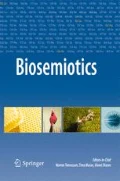Abstract
The present paper stems from the biosemiotic modelling of individual artificial cognition proposed by Ferreira and Caldas (2012) but goes further by introducing the concept of Umwelt Overlap. The introduction of this concept is of fundamental importance making the present model closer to natural cognition. In fact cognition can only be viewed as a purely individual phenomenon for analytical purposes. In nature it always involves the crisscrossing of the spheres of action of those sharing the same environmental bubble. Plus, the incorporation of that concept is vital to understand the complex semiosis that sustains collective tissues, societies, regulating collective cognition and consequently cooperative action. The concept of Umwelt Overlap broadens the range of applicability of the previous model to several distinct domains allowing for example for its application to multi-agent cooperative autonomous systems. In this paper a Middle Size League RoboCup soccer team is used as an example of a possible application.












Similar content being viewed by others
Notes
Cf. Maturana (1978).
By subjective we mean lead by an experiencer subject: the cognitive entity.
In general (Nl × Nc) indicates de dimensions of a matrix, Nl being the number of its rows and Nc that of its columns; thus, (N × 1) represents an N-component vector in the form of a column matrix.
This is also true for the human world, though with an increased level of complexity, as individuals normally play several roles in the social tissue. For instance, an adult plays a role in the family circle, a role in the work circle, a role in the friend’s circle… (cf. Ferreira 2007). The overlapping of these individual spheres defines both the human being’s Umwelt and his identity. On the other hand, it is by the crisscrossing of these specific individual spheres with the particular spheres of those he interacts within distinct domains that the individual’s and the society’s goals are achieved.
These castes can in some African species be four: soldier ants exclusively responsible for the defence of the colony.
Detrain and Deneubourg (2006) refer that threshold to stimuli change as time goes on depending on individual experience. Ants are also capable of associative learning by linking food rewards to previously meaningless stimuli such as visual landmarks or topochemical stimuli.
In this work environmental cues are understood as comprehending those that emerge from the exclusive physical environment and those that are provided by the specific behaviours of congeners (sometimes called communication) and by behaviour of opponents.
In the Gibsonian tradition these salient environmental cues are “affordances”.
We prefer to use the concept of “domain of knowledge/domain of experience”. In fact the domain of knowledge, though initially defined by programmers develops in autonomous systems through individual experience in the interaction with the surrounding environment, being this way progressively actualised.
References
Ahmad, A. & Lima, P. (2011). Multi-Robot Cooperative Object Tracking Based on Particle Filters, Proceedings of European Conference on Mobile Robots, September 7–9, 2011, Örebro, Sweden.
Chang, C. H., Wang, S. C., & Wang, C. C. (2011). Vision-Based Cooperative Simultaneous Localization and Tracking, 2011 I.E. International Conference on Robotics and Automation, May 9–13, 2011, Shanghai, China.
Detrain, C. & Deneubourg, J. L. (2006). Self-organized structures in a superorganism: do ants behave like molecules? Physics of Life Reviews, 3, 162–187.(available @ www.sciencedirect.com).
Ferreira, M. I. A. (2007). On Meaning: The phenomenon of individuation and the definition of a world view. Ph.D thesis. Faculty of Letters. University of Lisbon, Lisbon, Portugal.
Ferreira, M. I. A. & Caldas, M. G. (2012). Modelling Artificial Cognition in Biosemiotic Terms. Biosemiotics. doi:10.1007/s12304-012-9159-z.
Lima, P., Santos, P., Oliveira, R., Ahmad, A., & Santos, J. (2011). In R. S. Javier, E. Chown, & P. G. Ploeger (Eds.), Cooperative Localization Based on Visually Shared Objects, RoboCup 2010: Robot Soccer World Cup XIV—Lecture Notes in Computer Science (Vol. 6556/2011, pp. 350–361). Berlin/Heidelberg: Springer.
Maturana, H. R. (1978). Biology of language: The epistemology of reality. In G. Miller & E. Lenneberg (Eds.), Psychology and biology of language and thought. New York: Academic.
Rocha, L. M. (2012). Complex Systema Modeling: Using Metaphors from Nature in Simulation and Scientific Models. Based on Rocha, L. M. (1999) BITS: Computer and Communications News. Computing Information and Communications Division. Los Alamos National Laboratory 1999.
Stone, P., & Veloso, M. (2000). Multiagent systems: a survey from a machine learning perspective. Autonomous Robots, 8, 345–383.
von Uexkull, J. (1909). Umwelt und Innenwelt der Tiere. Berlin: Springer.
von Uexküll, J. (1934). A Stroll Through the Worlds of Animals and Men—a picture book of invisible worlds. In C.H. Schiller (Ed.), Instinctive Behaviour, the Development of a Modern Concept. New York: International Universities Press.
Author information
Authors and Affiliations
Corresponding author
Rights and permissions
About this article
Cite this article
Ferreira, M.I.A., Caldas, M.G. The Concept of Umwelt Overlap and its Application to Cooperative Action in Multi-Agent Systems. Biosemiotics 6, 497–514 (2013). https://doi.org/10.1007/s12304-013-9185-5
Received:
Accepted:
Published:
Issue Date:
DOI: https://doi.org/10.1007/s12304-013-9185-5




